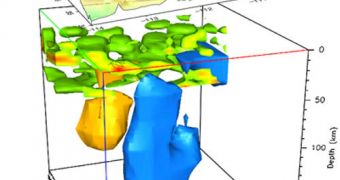For many years, experts have been trying to figure out how is it that the Colorado plateau formed. Though they conducted a large number of studies, the issue still remained cloudy. Now, a theory is proposing an interesting approach to looking at this issue.
Landscape features such as the Grand Canyon and Monument Valley were carved or otherwise put together by natural forces over tens of millions of years of evolution. But when experts tried to find the forces at work in raising the Colorado plateau, they bumped their heads into a wall.
What the new study suggests is that experts have been looking for answers in the wrong place. The forces that drove the plateau upwards acted from beneath, and more specifically in lava pockets.
The research demonstrates that hot, molten rock is swelling upwards from Earth's mantle, the layer of magma that separates the crust from the outer core. As this swelling occurs, large blobs of the stuff drip off the bottom of the plateau.
According to Rice University expert Alan Levander, the leader of the new work, this effect “looks kind of like a lava lamp.” The landscape feature is located at the point where the corners of Utah, Colorado, New Mexico and Arizona come together.
What is very interesting about this landscape feature is the fact that it tends to behave like a single block, or chunk of surface. Despite the fact that all around it geological forces are crumpling up the land, it is still behaving as if it's a single block.
In order to conduct the new study, the research team turned to the USArray for assistance. This is a network of seismic sensors, that allow geologists to determine how seismic waves travel through the mantle and the crust.
Data collected for the area immediately below the Colorado plateau reveal the existence of a massive blob of magma, at a depth of about 120 miles, or 200 kilometers. The most reasonable assumption to make is that this is a piece of Earth's crust, that came loose from the bottom of the plateau.
Though this theory goes a long way towards explaining some of the particularities this area has, some investigators warn against jumping to conclusions, Wired reports.
“The tendency is to say we have what looks like a drip and therefore it is a drip. We need to be really careful about that interpretation,” explains University of New Mexico in Albuquerque geophysicist Mousumi Roy.

 14 DAY TRIAL //
14 DAY TRIAL //